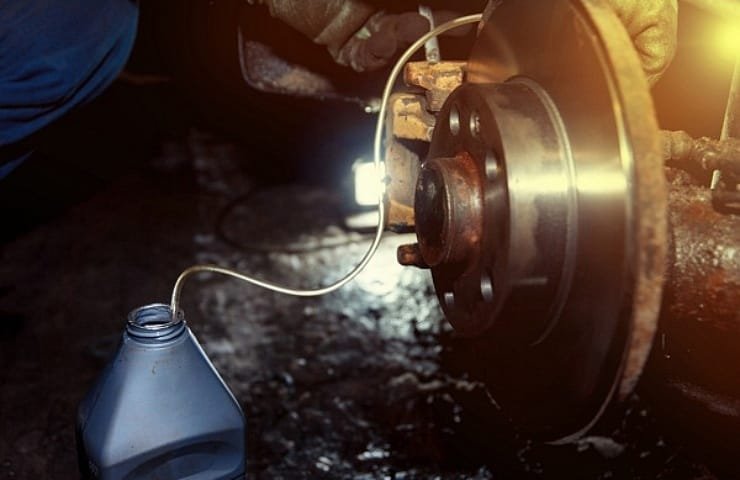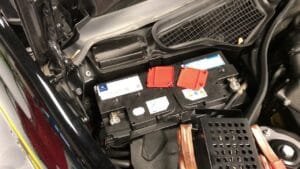A firm and responsive brake pedal is essential for safe driving. If your brakes feel spongy or soft, it could be due to air trapped in the brake lines. Normally, the best way to remove air is by bleeding the brake system, but that’s not always possible for every car owner.
Bleeding requires specialized tools and time, which may not be convenient for someone who doesn’t have experience with brake systems.
Fortunately, there are alternative methods to get air out of the brake lines without traditional bleeding. These techniques can help restore braking performance without needing to open the system completely.
However, it’s crucial to ensure your brakes are working properly, as air in the system can lead to dangerous braking failures.
In this guide, we’ll go over the possible ways to remove air from brake lines without bleeding, how air gets trapped in the system, and when a full bleed may still be necessary.
How Air Gets Into Brake Lines
Air can enter the brake lines due to several reasons, including:
✔ Brake fluid replacement – If the system is not refilled properly, air pockets can form.
✔ Leaks in the brake system – Damaged lines, seals, or master cylinder issues can let air in.
✔ Low brake fluid levels – If the reservoir runs low, air can enter when the fluid is replenished.
✔ Brake system repairs – Opening the system for repairs can introduce air into the lines.
Once air is inside the brake lines, it compresses when you press the brake pedal, making the braking response feel weak or inconsistent.
How to Remove Air from Brake Lines Without Bleeding
If you don’t want to go through a full bleeding process, here are alternative methods that may help remove trapped air from your brake system:
1. Pumping the Brake Pedal Method
🔹 Best for: Small air bubbles in the system
🔹 What You Need: None
Steps:
- Make sure the brake fluid reservoir is full. If it’s low, top it up with the correct type of brake fluid.
- With the car off, pump the brake pedal slowly about 30 to 50 times. This motion helps push air bubbles back toward the master cylinder.
- Start the car and press the brake pedal firmly. If the pedal feels firmer, the method may have worked.
- Check the fluid level again and refill if necessary.
💡 Why It Works:
Pumping the pedal repeatedly moves air through the system gradually, helping it rise back to the reservoir where it can escape naturally.
2. Gravity Method
🔹 Best for: Slow air removal over time
🔹 What You Need: A clear plastic hose, small container, and brake fluid
Steps:
- Locate the brake bleeder valve on each wheel.
- Attach a clear plastic hose to the valve and place the other end in a small container with brake fluid.
- Open the bleeder valve slightly and allow gravity to pull fluid and air bubbles out.
- Keep an eye on the fluid reservoir to ensure it doesn’t run dry.
- Once no air bubbles are visible in the hose, close the bleeder valve.
- Repeat for each wheel if needed.
💡 Why It Works:
This method allows air to escape naturally, without actively pressing the brake pedal. However, it is slow and may not work for large amounts of trapped air.
3. Tapping the Brake Lines and Master Cylinder
🔹 Best for: Dislodging small air bubbles stuck in the system
🔹 What You Need: A small rubber mallet or screwdriver handle
Steps:
- Locate the brake lines running from the master cylinder to each wheel.
- Lightly tap the brake lines with a rubber mallet or the handle of a screwdriver.
- Tap the master cylinder as well to loosen any trapped air bubbles.
- Let the car sit for a few minutes, allowing air to rise naturally to the reservoir.
- Pump the brake pedal a few times and check for improvements.
💡 Why It Works:
This method loosens trapped air bubbles, allowing them to move upward toward the master cylinder and exit through the brake fluid reservoir.
4. Letting the Car Sit Overnight
🔹 Best for: Minor air bubbles in the brake system
🔹 What You Need: Time and patience
Steps:
- Ensure the brake fluid reservoir is full.
- Park the car on a level surface and do not press the brake pedal for several hours or overnight.
- Air bubbles may naturally rise and escape into the reservoir.
- Check the brake fluid level in the morning and refill if necessary.
- Test the brakes by pressing the pedal a few times.
💡 Why It Works:
Given enough time, small air bubbles naturally rise through the brake fluid and escape into the reservoir, especially if they are near the master cylinder.
5. Reverse Bleeding Using a Syringe
🔹 Best for: Moving air from the brake lines back to the master cylinder
🔹 What You Need: Large syringe and clear tubing
Steps:
- Fill a large syringe with fresh brake fluid.
- Connect a clear hose from the syringe to the brake bleeder valve.
- Open the bleeder valve slightly and push brake fluid backward into the system using the syringe.
- Close the bleeder valve before removing the syringe.
- Repeat for each brake caliper if needed.
💡 Why It Works:
Instead of trying to force air downward, this method pushes air back toward the reservoir, where it can escape naturally.
When You Should Consider Full Bleeding
While these methods can help in many cases, they are not always a complete solution. A full brake bleed may still be required if:
- The brake pedal remains soft or spongy after trying these techniques.
- There is visible air in the brake fluid reservoir that doesn’t disappear.
- You recently had major brake repairs (replacing calipers, master cylinder, etc.).
- The car has ABS (Anti-lock Braking System), which can trap air deeper in the system.
If you experience these issues, a proper manual, vacuum, or pressure bleed is recommended for full air removal.
How to Prevent Air from Entering Brake Lines
✔ Regularly check and top up brake fluid to prevent air entry.
✔ Never let the brake fluid reservoir run dry when replacing fluid.
✔ Inspect brake lines and seals for leaks to avoid air intrusion.
✔ Use proper bleeding techniques if performing brake maintenance.
If your brakes feel spongy or unresponsive, trapped air in the brake lines could be the cause. While bleeding is the best method to remove air, there are several alternative techniques you can try, such as pumping the brake pedal, tapping the brake lines, using gravity, or letting the car sit overnight. These methods work best for small air pockets and minor issues but may not be effective for large amounts of air or severe brake system problems.
Ensuring that your brake system is properly maintained will keep your vehicle safe and responsive on the road. If your brakes don’t improve after trying these methods, a professional brake service is highly recommended.



